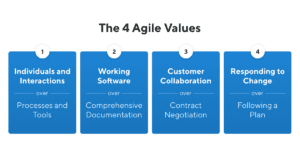Agile Manifesto
When getting started with Agile, it's essential for teams to learn what agile stands for, its principles, and what its values are.
In this guide, we'll discuss all of these in detail.
“Our highest priority is to satisfy the customer through early and continuous delivery of valuable. Manifesto, see Extending the Agile Manifesto – 2018. The Disciplined Agile Manifesto is an extension of the original Manifesto for Agile Software Development, written in 2001, that reflects the philosophies behind the Disciplined Agile (DA) toolkit. For a discussion of our thinking behind this manifesto, see Extending the Agile Manifesto. What is the Agile Manifesto? The Agile Manifesto is a brief document built on 4 values and 12 principles for agile software development. The Agile Manifesto was published in February 2001 and is the work of 17 software development practitioners who observed the increasing need for an alternative to documentation-driven and heavyweight software development processes.
Introduction To Agile Manifesto
How a group of engineers changed software development forever.
With market conditions and requirements changing rapidly, the software world has moved away from traditional waterfall based delivery models to a more iterative, customer centric delivery model. Today, the word “agile” is something that almost every software engineer has heard at some point or the other.
But it wasn’t always this way.
The agile movement was started at a ski resort in Snowbird, Utah. In this small town near Salt Lake City, 17 prominent engineers gathered together in February 2001 to create and sign the agile manifesto. This document would fundamentally change the way teams imagined, built, and deployed software products.
What Is Agile Manifesto?
The agile manifesto consists of four values and twelve guiding principles that shape agile delivery methodologies. Each methodology may follow these values and principles to different degrees but the overwhelming theme of all agile frameworks are:
- Increased customer collaboration
- Prioritizing the regular delivery of functional software.
The 4 Values of The Agile Manifesto
1. Individuals and Interactions Over Processes and Tools
The agile manifesto’s first value makes clear that agile teams must prioritize individuals and team interactions over recommended processes and tools. To put it simply, processes and tools should be implemented only when team members are comfortable using them - both individually and collectively.
2. Working Software Over Comprehensive Documentation
Before Agile went mainstream, there was a heavy focus on comprehensive documentation for every part of software built. This took up quite a bit of time and resources and heavily impacted delivery time. With agile, the focus was to be on delivering smaller, working components/prototypes frequently that required less on technical documentation, when compared to fully developed software.
3. Customer Collaboration Over Contract Negotiation
One of the most important differentiators of the agile manifesto is the emphasis on customer-centricity. The agile manifesto insisted that traditional software development was too one sided to truly be efficient. It sought to transform the end customer and actively involve them in the software development process. This idea was that increased customer collaboration would lead to regular course corrections and result in higher quality software delivery.
4. Responding to Change Over Following a Plan
To continue the theme of customer-centricity, the last value of the agile manifesto was to embrace change. In traditional methods of software development, change in requirements and specs was frowned upon as it resulted in wasted effort and missed deadlines. The agile manifesto argued that change was inevitable and an important part of building and shipping better software. The focus was now to be on incorporating regular customer feedback and making changes to requirements and specifications: on the go.
The 12 Principles of The Agile Manifesto
1. Customer satisfaction through early and continuous software delivery
The agile manifesto recommends that teams break down large projects into smaller, shippable components. The idea is to release these components faster and in regular intervals and keep the customers involved in the process. This continuous progress helps increase customer trust and satisfaction.

2. Accommodate changing requirements throughout the development process
In agile practices, changing requirements are seen as inevitable and development teams need to make room for changes in requirements and specifications.
Drivers 3dfx voodoo3. 3. Frequent delivery of working software
Frequent delivery is an important principle of the agile manifesto. The emphasis of delivering working software, as often as possible is to get the product out to be market-tested as soon and as often as possible.

4. Collaboration between the business stakeholders and developers throughout the project
The Agile manifesto sought to transform the software development process from a siloed process to a collaborative one. Customers are seen as an integral part of the development process rather than mere end users of the product.
5. Support, trust, and motivate the people involved
This principle is a reflection of the first value of the Agile manifesto. The idea that the people building software must help and support each other is central to ensuring that the best quality of software is delivered.
6. Enable face-to-face interactions
Communication between team members benefits greatly when face to face interactions happen whenever possible. Roadblocks get removed faster and people can share expertise to help solve problems faster.
7. Working software is the primary measure of progress
The agile manifesto measures progress through the constant release of market-testable software. The goal is to deliver working software as regularly as possible. All other metrics being monitored should help further this goal of shipping predictably and often.
8. Agile processes to support a consistent development pace
Teams should work on establishing processes that help them maintain velocity and ship software at a predictable pace. Once these processes are established, they can be tweaked for improvement.
9. Attention to technical detail and design enhances agility
The final quality of software being shipped depends largely on the quality of the technical and design specifications. Efforts should be made to have a team in place to deliver high quality specifications to ease the burden on delivery teams.
10. Simplicity
Focus on delivering effective software that meets requirements. This principle was created to ensure that development teams don’t overcomplicate when it comes to making technical decisions and implement them.
11. Self-organizing teams encourage great architectures, requirements, and designs
The agile manifesto encourages organizations to create self managing teams that have the knowledge and cross-functional skills to take ownership and tackle roadblocks effectively.
12. Regular reflections on how to become more effective
Improving processes constantly is one of the principles encouraged by the agile manifesto. Most agile frameworks have meetings for performance reviews or retrospectives that reflect on team performance improvements that can be made.
If you're looking for a project management software that will allow you to implement these values and principles, we've put together a comparison of agile tools list. This should help you evaluate a tool for your team.
We are uncovering better ways of developing
software by doing it and helping others do it.
Through this work we have come to value:
Individuals and interactions over processes and tools
Working software over comprehensive documentation
Customer collaboration over contract negotiation
Responding to change over following a plan
the right, we value the items on the left more.

| Kent Beck Mike Beedle Arie van Bennekum Alistair Cockburn Ward Cunningham Martin Fowler | James Grenning Jim Highsmith Andrew Hunt Ron Jeffries Jon Kern Brian Marick | Robert C. Martin Steve Mellor Ken Schwaber Jeff Sutherland Dave Thomas |
© 2001, the above authors
this declaration may be freely copied in any form,
but only in its entirety through this notice.
Twelve Principles of Agile Software
View Signatories
About the Authors
About the Manifesto

Agile Manifesto Pdf
Afrikaans
Albanian
Amharic
عربي
Azərbaycanca
Беларуская
Bosanski
Български
Català
Česky
Deutsch
Dansk
Ελληνικά
English
Español
Eesti
Euskara
Suomi
Français
Gaeilge
Gàidhlig
Galician
Galego
ქართული
עברית
हिंदी
Croatian/Hrvatski
Hungarian/Magyar
Bahasa Indonesia
Íslenska
Italiano
日本語
ខ្មែរ
한국어
Latviešu
Lietuvių
Македонски/Macedonian
Bahasa Melayu
မြန်မာစာ
नेपाली
Nederlands
Norsk
ଓଡ଼ିଆ
ਪੰਜਾਬੀ
Polski
فارسی
Português Brasileiro
Português Portugal
Română
Русский
සිංහල
Slovenščina
Slovensky
संस्कृत
Srpski
Svenska
Swahili
தமிழ்
తెలుగు
ภาษาไทย
Filipino
Türkçe
Xitsonga
Українська
اردو
Yoruba
繁體中文
简体中文
Https://agilemanifesto.org/
Agile Manifesto Pdf
site design and artwork © 2001, Ward Cunningham